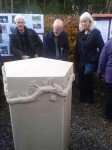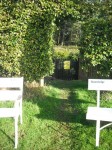Over the course of five trials in 1662, a court convened in the peaceful hamlet of Crook of Devon, County of Perth in central Scotland tried 13 people for witchcraft. Out of that number, ten women and one man were condemned and executed. The convicted witches were brought to a grassy knoll in a field called Lamblaires near today’s Village Hall, strangled by the hangman and then burnt at the stake. There has been no memorial to the deceased in the village, although this sad chapter in history is well known as a particularly ugly example of the trend of witch burnings that year in Scotland.
 Lord Moncrieff, owner of the 17th century Tullibole Castle a mile east of Crook of Devon, has rectified that shameful oversight 350 years after the trials. Starting in 2003, he created a circular maze 100 feet in diameter made out of 2000 beech trees. At its center is the pentagon pillar, a five-sided column with the names of the trials’ victims and the dates of their condemnation inscribed on each side. The completed maze and memorial were unveiled on October 25th.
Lord Moncrieff, owner of the 17th century Tullibole Castle a mile east of Crook of Devon, has rectified that shameful oversight 350 years after the trials. Starting in 2003, he created a circular maze 100 feet in diameter made out of 2000 beech trees. At its center is the pentagon pillar, a five-sided column with the names of the trials’ victims and the dates of their condemnation inscribed on each side. The completed maze and memorial were unveiled on October 25th.
It’s particularly fitting that Tullibole Castle should dedicate a space to the persecuted, since in 1662 it was the home of William Halliday, the laird of Tullibole who, along with his son, his baillie, the ministers of four area parishes and other prominent locals appointed themselves a tribunal to dig up evidence of guilt. They spent months questioning witnesses and torturing the accused into confessions that would incriminate new people who would then be “investigated,” their guilt never in question.
 These extorted confessions and ludicrous witness statements were then presented as the sole evidence against the accused at the official trials. Presided over by His Majesty’s Justice-General Depute Alexander Colville and adjudicated by a jury of 15 local men of reputation and means, these courts pretty much rubber-stamped the charges scared up by the local tribunal and pronounced sentence or doom (literally; doom was a synonym for judgement) upon the guilty. The minutes of these assizes have survived. You can read them collected in the Proceedings of the Society of Antiquaries of Scotland from 1887-1888.
These extorted confessions and ludicrous witness statements were then presented as the sole evidence against the accused at the official trials. Presided over by His Majesty’s Justice-General Depute Alexander Colville and adjudicated by a jury of 15 local men of reputation and means, these courts pretty much rubber-stamped the charges scared up by the local tribunal and pronounced sentence or doom (literally; doom was a synonym for judgement) upon the guilty. The minutes of these assizes have survived. You can read them collected in the Proceedings of the Society of Antiquaries of Scotland from 1887-1888.
Except for the testimony of the one convicted warlock, Robert Wilson, all of the extracted confessions describe sexual intercourse with Satan, who apparently was an ardent lover with a penchant for disguises. The interrogators were particularly interested in the appearance of the Devil, his fashion choices, his body temperature, and of course, in his sex life.  Here’s an example from the confession of Agnes Murie presented at the first trial, held on April 3rd, 1662, of Agnes Murie, Bessie Henderson and Isabella Rutherford.
Here’s an example from the confession of Agnes Murie presented at the first trial, held on April 3rd, 1662, of Agnes Murie, Bessie Henderson and Isabella Rutherford.
Lykeas for clearing of your said sorcerie and witchcraft that ye, being coming from the Crook Mill, about Martinmas last, 1661, Sathan did appear to you at the back of Tullibole yards, being on Monday, and said to you “will you be my servant and I will give you als much silver as will buy you as many corn as will serve you before Lammas,” whilk you granted. Likeways he desired you to renounce and forsake your baptism, whilk ye did, and he gave to you a new name calling you Rossina, whilk ye yourself did freely confess, and likeways at the same tune Sathan had the use of your body at the foot of the round knowe at the back of the yards of Tulliebole, and knew not whether his body was hot or cold, whilk ye did also freely confess.
Just in case that wasn’t lurid enough, the interrogators took it to an even creepier place when Agnes, who had named some names of her supposed covenmates and promised to reveal more, was later reticent to do so.
[Y]e freely confessed and promised to confess and delate some others. This ye did before Mr Alexander Ireland, minister, and Mr Robert Alexander, bailie, and thereafter being interrogated be the said minister what was the reason that hindered you to do the same presently, ye desired the said Mr Robert Alexander to lay his hand upon your breast to find how the lump troubled you and to put his hand behind your back and he would find als much trouble you there.
Yes I’m sure she desired her inquisitor to feel her up. No doubt that’s exactly how it went down.
Satan appeared to Isabel Rutherford in a jaunty outfit, complete with Scotch blue bonnet.
Likeways ye confesst that ye renounced your baptism, and immediately thereafter Sathan gave you an mark; and declared that Sathan was in likeness of a man with grey cloathes and ane blue bannet, having ane beard; as also ye confesst that when ye got the mark it was painful two or three days.
When she saw Satan again two or three weeks later, he was still “in the likeness of a man with ane blue bonnet and grey clothes.” His hand was cold and the rest of him was as well.
Likeways ye did confess that Sathan had carnal dealing with you at the east side of John Livingstone’s yard, and confesst that his body was cold and his seed likewise.
 It goes on and on like that, coerced hallucinatory self-incrimination after coerced hallucinatory self-incrimination interspersed with some testimony about sick ewes and oxen. These statements were read in the court, then the judge gave sentence and the dempster, a court officer whose position was often hereditary, gave doom, i.e., pronounced the sentence of the court.
It goes on and on like that, coerced hallucinatory self-incrimination after coerced hallucinatory self-incrimination interspersed with some testimony about sick ewes and oxen. These statements were read in the court, then the judge gave sentence and the dempster, a court officer whose position was often hereditary, gave doom, i.e., pronounced the sentence of the court.
For the whilk causes the above named Justice General Depute gives sentence and ordains, that the said Agnes Murie, Bessie Henderson, and Isabel Rutherford, sail be all three taken away to the place called the Lamlaires bewest the Cruick Miln the place of their execution to-morrow, being the fourth day of this instant month of April, betwixt one and two in the afternoon, and there to be stranglit to the death by the hand of the hangman, and thereafter their bodies to be burnt to ashes for their trespass, and ordains all their moveable goods and gear to be escheit and inbrought to his Majesty’s use for the causes foresaids. Whereupon William Donaldson dempster gave doom.
It was just happenstance that kept all 13 from meeting death at the public hangman’s hands. There is no record of Margaret Hoggin being sentenced or executed, but she is listed as deceased by the next trial two months later. Perhaps she was given a reprieve due to her advanced age of 79 and then died of natural causes/stress, or perhaps she died during imprisonment. Only Agnes Pittendreich survived the ordeal, and that was solely because she was pregnant at the time of the trial, not because she was exonerated. Justice-General Depute Colville ordained that she should be “put to liberty for the present, and that she should answer whenever she was called upon, within fifteen days under pain of death.” For whatever reason, she was never again called upon.
This was for her a fortunate turn of events, seeing how one of the other victims, Christian Grieve, was acquitted in the trial of July 21st, 1662, only to be subjected to a second trial on October 8th. Even though she had the exact same kind of tortured confession and witness evidence against her as was presented against everyone else, and even though no new charges or new evidence were presented, the first time she was acquitted while the second time she was convicted. Five days later she was strangled and burned.
 Lord Moncrieff sees the Witches Maze and pentagon pillar as a memorial to the innocents railroaded by a sham judicial system, but also as an indictment of the superstitions that underpinned and fed the trials. He doesn’t want this memorial to become a locus of neo-pagan or Wiccan beliefs as some of the other memorials to burned witches have. From this 2009 interview with The Scotsman:
Lord Moncrieff sees the Witches Maze and pentagon pillar as a memorial to the innocents railroaded by a sham judicial system, but also as an indictment of the superstitions that underpinned and fed the trials. He doesn’t want this memorial to become a locus of neo-pagan or Wiccan beliefs as some of the other memorials to burned witches have. From this 2009 interview with The Scotsman:
“Instead of being a simple memorial I want it to work on several levels. The witches’ pillar will be protected by five stones, to symbolize the five trials, which are decorated with what I call ‘good’ words. These are words such as logic, justice, tolerance, truth and love, which were missing from Scottish society at the time of the trials.”
Mirroring this, the maze also features a series of dead ends, which will be marked with negative words such as superstition, hypocrisy, prejudice and ignorance.
Moncrieff said, “If you don’t use logic inside the maze you will come to a dead end.”
For a factual overview about the persecution of witches in Scotland, see this introduction to the subject from The Survey of Scottish Witchcraft, an admirably ambitious project to create a database of all the people accused of witchcraft in Scotland between the passage of the anti-witchcraft act in 1563 and its repeal in 1736.
Of course, we all know that the fact that the belongings of the condemned reverted to the government (“his Majesty’s use for the causes foresaids”) had nothing to do with these cases. :giggle: I wonder how many of them had some sort of useful property?
Lord Moncrieff sounds like a great guy. :boogie:
Since all but one of them were women and most of them married, from a legal standpoint anything they had was just on loan from their husbands. The warlock fellow was probably the only one in the group with any property worth confiscating.
I agree; Lord Moncrieff is a cool cat for sure. The beech maze alone guarantees him a :notworthy: from me.
I couldn’t help wondering if he built it miz-maze style? Do you know if there’s an overhead shot of it anywhere?